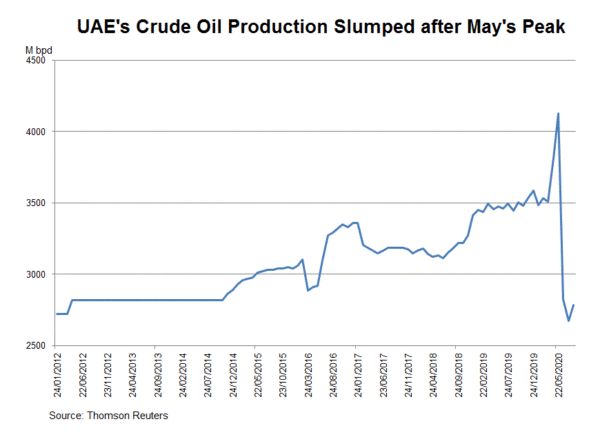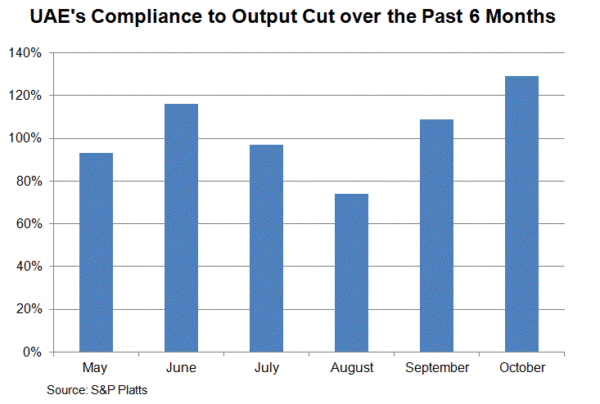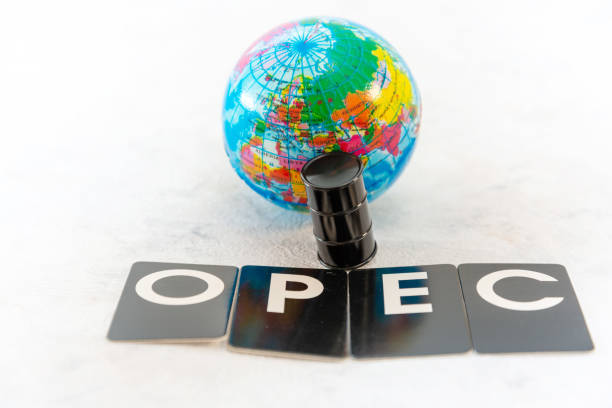While vaccine news should be bullish for the oil market, the rally in crude oil price proves short lived. Ahead of next week’s meeting to decide extension of output cuts, a long-term OPEC member, the UAE, reportedly has shown discontent about the output cut deal. There are rumors that the third largest OPEC producer has threatened to leave the cartel. Given comments from UAE’s oil minister, we do not expect the dissatisfaction would affect the decision next week. However, commitments of OPEC+ producers in output cuts, and thus the effectiveness of the deal to support oil price, in the future is in question.
In response to rumors that the country could leave the OPEC after being a member for 53 years, energy minister Suhail al-Mazrouei noted in a statement that “as a reliable and long-standing member of OPEC, we have always been open and transparent in all our decisions and strategies in support of OPEC”. It added that the country has “demonstrated this commitment through our compliance to the current OPEC+ agreement”. It is believed that UAE’s discontent was triggered by Saudi Arabia’s public criticism over the country’s overproduction in August.
According the various market data, the UAE produced about 4M b/d, of which about 3.1M bpd was crude oil in 2019. It is the third largest petroleum producer in OPEC after Saudi Arabia and Iraq. The producer has planned to expand crude oil production capacity from 3.5M bpd to 5M bpd in 2030. These plans could have been delayed by the OPEC output cut deal. Under the deal, the UAE agreed to produce 2.59M bpd from August to December 2020, compared with the previous quota of 2.45M bpd. UAE’s output in August was 2.74M bpd, +5.8% higher than its quota. In spite of its voluntary extra cut back in June, Saudi openly criticized the UAE, requesting it to “compensate” the cut in coming months.
– advertisement –
The UAE did reduce output significantly in September and October, producing 2.54M bpd and 2.42 M bpd and achieving compliance levels of 109% and 129%, respectively. Indeed, the UAE has been committed to production cuts over the past years, despite that it is in a more advantageous position than other producers given the low break-even oil price it enjoys.
OPEC+ next week will decide on the next step to output cut. The alliance agreed to reduce total output by 7.7M bpd from August to December, compared with 9.7M bpd from May to July. The output cut was scheduled to be tapered further to 5.7M bpd from January 2021 to April 2022. In light of the sluggish global economic recovery, some members of the alliance proposed to maintain the output cut of 7.7M bpd until 1Q21. A technical meeting held last suggested that most producers tentatively agreed to the idea. A final decision will be made next week (November 30-December 1).
We have little doubt that the extension will be approved by the majority of the participants. However, commitments of producers to the deal are in question as it appears that more producers are frustrated by the deal, in particular some producers habitually over-producers while others are exempted from quotas due to domestic reasons. Back in 2018, Qatar decided to quit OPEC, reportedly against the idea of the OPEC+ alliance and output cut deal. If the UAE is to follow suit, both the OPEC and the OPEC+ alliance would be on the verge of collapse. This would mean even less restraint to oil production in support of prices in the future.
